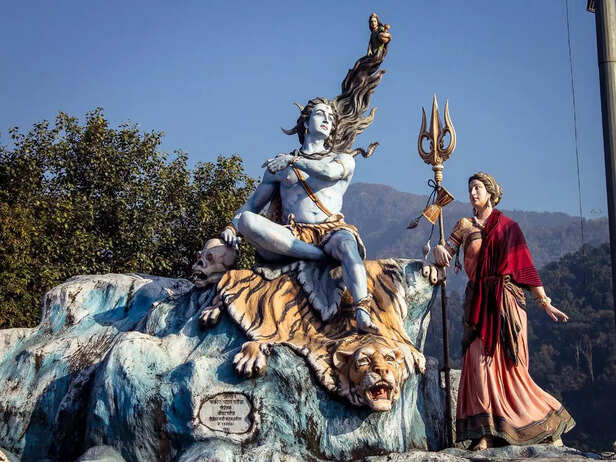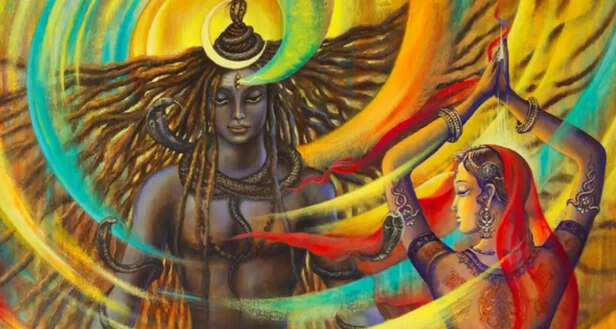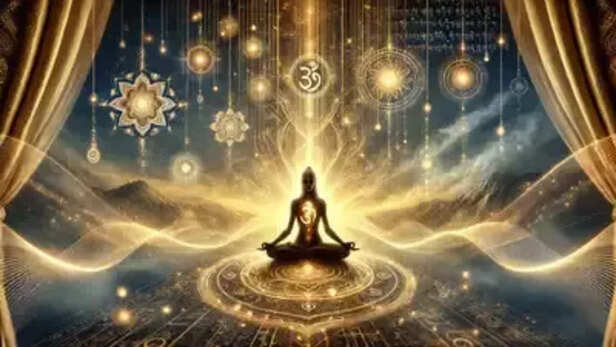Secrets of Tantra—Shiva in Conversation With Shakti
Ankit Gupta | Apr 13, 2025, 14:02 IST
Shiv-Shakti
The true essence of Tantra lies in this eternal conversation between consciousness (Shiva) and energy (Shakti). One is incomplete without the other. It is neither just about rituals nor merely abstract philosophy—it is about surrender, love, wisdom, secrecy, and initiation.
“त्वमेव प्रत्यक्षं तत्त्वमसि। त्वमेव केवलं कर्ताऽसि।
त्वमेव केवलं धर्ताऽसि। त्वमेव केवलं हर्ताऽसि।”
(You alone are the Supreme Truth. You alone are the Creator, the Preserver, and the Destroyer.)

Most modern seekers perceive Tantra as a technique—a powerful set of rituals or energy work. But this understanding is a fragment. At its core, Tantra is not a technique; it is a transmission. And this transmission begins with a divine dialogue—a sacred and intimate exchange between Shiva and Shakti.
Tantric scriptures are not sermons—they are conversations. The great texts like the Vijnana Bhairava Tantra, Rudrayamala Tantra, and Damar Tantra are essentially whispered secrets, lovingly exchanged in the silent, all-encompassing space of divine union.
Devi Parvati, representing Shakti—the eternal energy—poses profound questions:
Oh Lord, what is the nature of reality? How may one attain liberation? What is the secret of Mantra, Yantra, and Karya Siddhi?
To this, Shiva replies—not as a superior, but as a loving consort and a guru. This exchange forms the very heart of Tantra.
Yet, these sacred conversations were not meant for all. In many cases, they were overheard by Nandi, Ganapati, or Rishis in deep meditation and then shared in coded formats. This veil of secrecy was not for elitism—it was a spiritual safeguard. The energy released by these teachings, if handled unprepared, can destabilize rather than liberate.

Modern seekers often jump to mantras without knowing their backstory. But in Tantra, every mantra arises from an event, a conversation, a revelation. Without absorbing this context, one may chant the sound but miss the soul.
Take the Siddha Kunjika Stotra, for example—perhaps one of the most powerful keys to unlock the energy of the Durga Saptashati. It is not a regular hymn. It is a gateway mantra—one that encapsulates the Navarna Mantra (“ॐ ऐं ह्रीं क्लीं चामुण्डायै विच्चे”) in a subtle, encoded structure.
But how does it begin?
It begins with a conversation. In the Rudrayamala Tantra, Shiva tells Devi Parvati that even the Devas are unaware of this stotra. He insists that it must remain secret—revealed only to those who are initiated, disciplined, and purified. He even calls it the "most potent weapon" in Kali Yuga.
“Na Mantrāḥ Na Tantrāḥ Na Yantrāḥ,
Na Devi Na Pūjā Na Dhūpo Na Deepaḥ
Na Japyo Na Tantro Na Yāgo Na Yajñaḥ,
Siddha Kunjika Stotra Japāti Siddhiḥ”
(Neither mantra nor tantra, not even Devi puja or yajna—nothing is as effective in Kali Yuga as the chanting of Siddha Kunjika.)
Here, Shiva isn't just transmitting words—he's giving Devi a spiritual weapon, one that must be received in the right state of shraddha (devotion) and bhava (feeling).
That state is attained by reading their conversation repeatedly—letting it dissolve your ego, melt your logical mind, and open your heart.

While many Tantras begin with Devi seeking wisdom from Shiva, there are equally mystical moments when Shiva becomes the seeker.
In one such episode, Shiva asks a deeply human question:
O Devi, you are Bhakta Sulabhe—the one who is easily pleased by sincere devotees. But what is the secret to Karya Siddhi—success in work—in this dense, dark world of Kali Yuga?
And Devi smiles, her affection brimming. She says:
“O Mahadeva, out of love I will tell you a secret not even the Gods know. This is the key to success in all endeavors in Kali Yuga. This is Ambastuti.”
Ambastuti is rarely spoken of in mainstream discussions, yet it is a hidden gem in the Tantric tradition. It is a secret Stuti (hymn) to the Universal Mother, revealed by Devi to Shiva as a solution to practical problems of life.
Unlike Siddha Kunjika, which unlocks spiritual potency, Ambastuti grounds that energy into success in worldly undertakings—projects, responsibilities, aspirations.
Devi explains:

If one begins to contemplate deeply on the core of Tantric transmissions, a beautiful and consistent pattern becomes visible. Every great Tantric revelation begins not with intellectual arrogance or religious rigidity, but with a moment of pure, intense seeking. One of the Divine pair—either Shiva or Devi—enters a space of vulnerability, of deep yearning to know the Truth. There is humility in their questions, and love in their listening. A dialogue then unfolds, sacred and intimate, beyond the grasp of logic, drenched in the silence of devotion.
Shiva, the still consciousness, sometimes becomes the disciple of Shakti, the dynamic energy, and at other times, Shakti surrenders before the infinite silence of Shiva to receive the nectar of knowledge. This ever-shifting dynamic, where the teacher and the seeker merge into each other, forms the very fabric of Tantric wisdom. The teachings that emerge from such dialogues are not meant to be memorized; they are to be absorbed, breathed, lived, and finally, realized. Each mantra, each stotra, each practice carries the essence of this divine exchange—making Tantra not a mere collection of rituals, but a living breathing transmission.
This is why the guru in Tantra is not a position of dominance but a function of inner awakening. When the Divine Itself becomes the seeker and the guide, the seeker too must become Divine in humility and sincerity. The Vijnana Bhairava Tantra illustrates this perfectly, where Parvati asks questions not as the Goddess of the cosmos, but as a soul hungry for direct experience. In return, Shiva doesn’t give her dogma—he offers her 112 doors to the Infinite, each one a gateway to the present moment. Thus, the essence of Tantra is not in instruction, but in immersion. The teachings live not in books but in the quiet recesses of the Self.
Shiva repeatedly warns Devi to keep certain teachings hidden—even from the Gods. Why?
Because Tantra is not about moral righteousness or blind faith. It is about power—raw, sacred, unfiltered Shakti. Without purification, intention, and inner silence, that power can corrupt or destroy.
This is why secrecy is protection—not suppression. Just as high-voltage electricity requires insulation, high-frequency truths require containment.

True Tantra is not something you study, collect, or perform—it is something you become. It does not dwell in temples of stone or in the pages of ancient texts, but in the sacred temple of your inner consciousness. The rituals, mantras, yantras—all of them are vehicles, not destinations. Their purpose is to prepare the seeker to enter that space where Shiva and Shakti speak. In that silence of your own being, the Divine Conversation still continues. The real sadhana begins when you no longer feel separate from that dialogue.
To live the spirit of Tantra means to allow Shiva’s silence and Shakti’s speech to rise within you. It is to become both the question and the answer. When you sit in meditation, it is Devi who asks, “What is beyond this mind?” And it is Shiva within you who responds—not in words, but in a wave of stillness. The more you purify yourself through love, tapasya, and surrender, the more clearly you begin to hear them. The mantra becomes more than sound; it becomes your breath. The yantra becomes more than geometry; it becomes the map of your own consciousness. The stotra becomes more than praise; it becomes your inner voice calling out to its own Source.
This is the real purpose of Siddha Kunjika and Ambastuti—not to give power to the ego, but to melt the ego into divine alignment. When you chant with awareness, with understanding, and with deep surrender to the sacred context of the Shiva–Shakti dialogue, these mantras begin to open inner doors. You don’t just recite them—you are recited by them. You don’t just seek the Goddess—you are slowly, gracefully, unveiled as the Goddess Herself. This is the secret of Tantra. And once this transmission is received in the heart, the outer world becomes nothing but a reflection of the Divine Conversation unfolding within you.
Even today, the dialogue between Shiva and Shakti continues—within you. Every time you meditate, chant, or surrender, you enter that eternal space where Shiva seeks Shakti, and Shakti reveals Shiva.
Listen closely.
The conversation is not over.
It is waiting for you to tune in.
त्वमेव केवलं धर्ताऽसि। त्वमेव केवलं हर्ताऽसि।”
(You alone are the Supreme Truth. You alone are the Creator, the Preserver, and the Destroyer.)
Tantra is a Dialogue, Not a Doctrine

Shiv and Parvati
Most modern seekers perceive Tantra as a technique—a powerful set of rituals or energy work. But this understanding is a fragment. At its core, Tantra is not a technique; it is a transmission. And this transmission begins with a divine dialogue—a sacred and intimate exchange between Shiva and Shakti.
Tantric scriptures are not sermons—they are conversations. The great texts like the Vijnana Bhairava Tantra, Rudrayamala Tantra, and Damar Tantra are essentially whispered secrets, lovingly exchanged in the silent, all-encompassing space of divine union.
Devi Parvati, representing Shakti—the eternal energy—poses profound questions:
Oh Lord, what is the nature of reality? How may one attain liberation? What is the secret of Mantra, Yantra, and Karya Siddhi?
To this, Shiva replies—not as a superior, but as a loving consort and a guru. This exchange forms the very heart of Tantra.
Yet, these sacred conversations were not meant for all. In many cases, they were overheard by Nandi, Ganapati, or Rishis in deep meditation and then shared in coded formats. This veil of secrecy was not for elitism—it was a spiritual safeguard. The energy released by these teachings, if handled unprepared, can destabilize rather than liberate.
The Hidden Context Before Every Mantra

Mantra connects the Consciousness
Modern seekers often jump to mantras without knowing their backstory. But in Tantra, every mantra arises from an event, a conversation, a revelation. Without absorbing this context, one may chant the sound but miss the soul.
Take the Siddha Kunjika Stotra, for example—perhaps one of the most powerful keys to unlock the energy of the Durga Saptashati. It is not a regular hymn. It is a gateway mantra—one that encapsulates the Navarna Mantra (“ॐ ऐं ह्रीं क्लीं चामुण्डायै विच्चे”) in a subtle, encoded structure.
But how does it begin?
It begins with a conversation. In the Rudrayamala Tantra, Shiva tells Devi Parvati that even the Devas are unaware of this stotra. He insists that it must remain secret—revealed only to those who are initiated, disciplined, and purified. He even calls it the "most potent weapon" in Kali Yuga.
“Na Mantrāḥ Na Tantrāḥ Na Yantrāḥ,
Na Devi Na Pūjā Na Dhūpo Na Deepaḥ
Na Japyo Na Tantro Na Yāgo Na Yajñaḥ,
Siddha Kunjika Stotra Japāti Siddhiḥ”
(Neither mantra nor tantra, not even Devi puja or yajna—nothing is as effective in Kali Yuga as the chanting of Siddha Kunjika.)
Here, Shiva isn't just transmitting words—he's giving Devi a spiritual weapon, one that must be received in the right state of shraddha (devotion) and bhava (feeling).
That state is attained by reading their conversation repeatedly—letting it dissolve your ego, melt your logical mind, and open your heart.
The Role Reversal: When Shakti Becomes the Guru

Adi-Shakti
While many Tantras begin with Devi seeking wisdom from Shiva, there are equally mystical moments when Shiva becomes the seeker.
In one such episode, Shiva asks a deeply human question:
O Devi, you are Bhakta Sulabhe—the one who is easily pleased by sincere devotees. But what is the secret to Karya Siddhi—success in work—in this dense, dark world of Kali Yuga?
And Devi smiles, her affection brimming. She says:
“O Mahadeva, out of love I will tell you a secret not even the Gods know. This is the key to success in all endeavors in Kali Yuga. This is Ambastuti.”
Ambastuti – The Secret of Karya Siddhi in Kali Yuga
Unlike Siddha Kunjika, which unlocks spiritual potency, Ambastuti grounds that energy into success in worldly undertakings—projects, responsibilities, aspirations.
Devi explains:
- Chanting Ambastuti forms an energetic shield around the practitioner.
- It invokes the Anugraha Shakti (blessing power) of the Goddess.
- It neutralizes negative karma that blocks fruition of effort.
- And most importantly, it attracts the alignment of cosmic will with personal desire, which is the real secret behind success.
The Sacred Pattern of All Tantric Knowledge

The First Yogi
If one begins to contemplate deeply on the core of Tantric transmissions, a beautiful and consistent pattern becomes visible. Every great Tantric revelation begins not with intellectual arrogance or religious rigidity, but with a moment of pure, intense seeking. One of the Divine pair—either Shiva or Devi—enters a space of vulnerability, of deep yearning to know the Truth. There is humility in their questions, and love in their listening. A dialogue then unfolds, sacred and intimate, beyond the grasp of logic, drenched in the silence of devotion.
Shiva, the still consciousness, sometimes becomes the disciple of Shakti, the dynamic energy, and at other times, Shakti surrenders before the infinite silence of Shiva to receive the nectar of knowledge. This ever-shifting dynamic, where the teacher and the seeker merge into each other, forms the very fabric of Tantric wisdom. The teachings that emerge from such dialogues are not meant to be memorized; they are to be absorbed, breathed, lived, and finally, realized. Each mantra, each stotra, each practice carries the essence of this divine exchange—making Tantra not a mere collection of rituals, but a living breathing transmission.
This is why the guru in Tantra is not a position of dominance but a function of inner awakening. When the Divine Itself becomes the seeker and the guide, the seeker too must become Divine in humility and sincerity. The Vijnana Bhairava Tantra illustrates this perfectly, where Parvati asks questions not as the Goddess of the cosmos, but as a soul hungry for direct experience. In return, Shiva doesn’t give her dogma—he offers her 112 doors to the Infinite, each one a gateway to the present moment. Thus, the essence of Tantra is not in instruction, but in immersion. The teachings live not in books but in the quiet recesses of the Self.
Why Secrecy in Tantra?
Because Tantra is not about moral righteousness or blind faith. It is about power—raw, sacred, unfiltered Shakti. Without purification, intention, and inner silence, that power can corrupt or destroy.
This is why secrecy is protection—not suppression. Just as high-voltage electricity requires insulation, high-frequency truths require containment.
The True Spirit of Tantric Sadhana

Sadhana
True Tantra is not something you study, collect, or perform—it is something you become. It does not dwell in temples of stone or in the pages of ancient texts, but in the sacred temple of your inner consciousness. The rituals, mantras, yantras—all of them are vehicles, not destinations. Their purpose is to prepare the seeker to enter that space where Shiva and Shakti speak. In that silence of your own being, the Divine Conversation still continues. The real sadhana begins when you no longer feel separate from that dialogue.
To live the spirit of Tantra means to allow Shiva’s silence and Shakti’s speech to rise within you. It is to become both the question and the answer. When you sit in meditation, it is Devi who asks, “What is beyond this mind?” And it is Shiva within you who responds—not in words, but in a wave of stillness. The more you purify yourself through love, tapasya, and surrender, the more clearly you begin to hear them. The mantra becomes more than sound; it becomes your breath. The yantra becomes more than geometry; it becomes the map of your own consciousness. The stotra becomes more than praise; it becomes your inner voice calling out to its own Source.
This is the real purpose of Siddha Kunjika and Ambastuti—not to give power to the ego, but to melt the ego into divine alignment. When you chant with awareness, with understanding, and with deep surrender to the sacred context of the Shiva–Shakti dialogue, these mantras begin to open inner doors. You don’t just recite them—you are recited by them. You don’t just seek the Goddess—you are slowly, gracefully, unveiled as the Goddess Herself. This is the secret of Tantra. And once this transmission is received in the heart, the outer world becomes nothing but a reflection of the Divine Conversation unfolding within you.
The Divine Conversation Never Ends
Listen closely.
The conversation is not over.
It is waiting for you to tune in.
